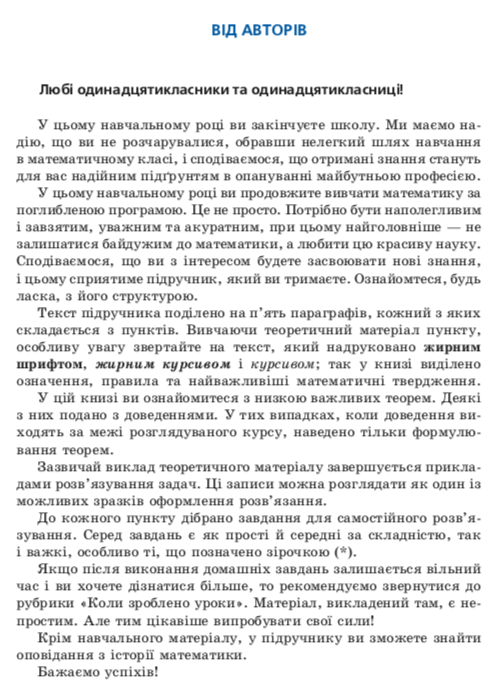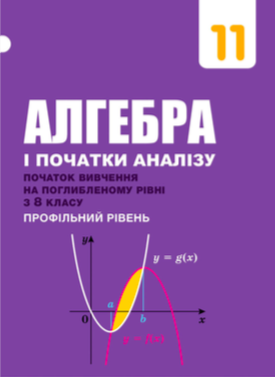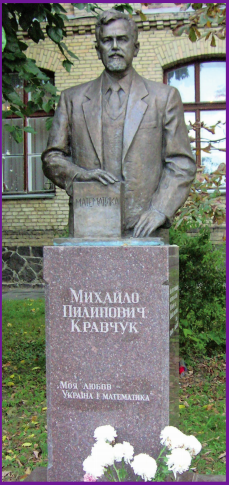I had a particularly enjoyable morning with my Year 13s today, eating a chocolate chip muffin and trying out any maths problems we could find online. This led to me discovering a Ukrainian maths textbook and so I thought I’d share some insights and comparisons with what we have in the UK.
[Other somewhat-related posts from years gone by: German ‘A level’; Russian ‘A level’. And some recent tweets with exam questions from the Netherlands.]
The Opening Pages
Algebra and the beginnings of analysis (Merzlyak et al, 2019) is a textbook for the 11th class, which in Ukraine is the final school year. My understanding is that after the 8th class, students begin to specialise (to some extent) in their subject choices and this book is for those who go down a more mathematical pathway. One of the first things to notice is that the book is recommended by the Ministry of Education and Science of Ukraine.
The book opens with a patriotic and motivational quotation inscribed on a monument to the scientist Kravchuk: My love is Ukraine and mathematics. With the added caption “We hope that this patriotic statement of a prominent Ukrainian mathematician will be a reliable guide for you on the path to professionalism.”

There is an introductory From the authors message, enthusiastically welcoming the 11th class students. They remind students of the need…
“to be persistent, attentive and accurate, and most importantly – do not remain indifferent to mathematics, and love this beautiful science”.
They also point out two additional features of the text: “If after homework there is free time and you want to learn more, we recommend to refer to the section “When the lessons are done”. The material presented there is not easy. But the more interesting to test your strength! In addition to educational material, in the textbook you can find stories on the history of mathematics.” They close by wishing the students success!
Contents & Anatomy
I would assume that the contents of this textbook are a good proxy for the syllabus content for the students’ course. Across 300 pages, we find:
- Section 1 (Chapters 1-8; ~80 pages): Exponential and logarithm functions
- Section 2 (Chapters 9-12; ~50 pages) Integrals and their application
- Section 3 (Chapters 13-19; ~70 pages) Elements of probability theory
- Section 4 (Chapters 18-22; ~40 pages) Complex numbers
- Section 5 (Chapters 23-25; ~20 pages) Polynomials
The book closes with 40 pages of short answers for all the exercises, an index and a table of contents.
Each chapter comprises a developmental discussion of the theory (including use of the language of ‘lemma’ and ‘theorem’ etc), example problems and then a substantial exercise. For example, Chapter 1 finishes with a set of 52 problems, many of which have multiple sub-parts.
Each section closes with some “When the lessons are done” material and then a summary of the key points covered throughout its chapters. At the end of Section 1, for example, we meet Kravchuk again and learn that he “attached great importance to educational work with young people, in particular, on his initiative in 1935 the first Kyiv Mathematical Olympiad for schoolchildren was held”. The problems from that competition are then included:

Section 2’s enrichment includes the classic discussion of Newton and Leibniz, but also discusses the much less well-known work of Cavalieri.
Careful development of the theory – a closer look at Chapter 1
The very first chapter, whose primary focus is the function f(x)=ax, discusses briefly what it can mean to raise a number to an irrational power (as the limit of a sequence with rational powers) – something which we, or at least our textbooks, simply take for granted. I wouldn’t say the treatment is quite as rigorous as an undergraduate approach, but it’s nice to see a discussion that uses limits. The language of lemma, theorem and proof is used: eg a lemma is included, proving that “if a>1 and x>0, then ax>1″.
The chapter discussion continues to prove that ax is increasing for a>1, and decreasing for a in (0,1). And even demonstrates its continuity with a limit-of-sequences approach. Also included is the Cauchy functional equation f(x+y)=f(x)f(y) and a discussion about modelling bacterial growth (constant proportional growth over equal time intervals) reduces to this relation, from which we can therefore deduce that the model is exponential. (That Cauchy’s equation implies an exponential function is the final challenge problem at the end of the chapter!)
The thoroughness of the discussion is perhaps also exemplified by the summary table for the function that appears just before the main worked problems and exercise set.

Exercises
A common complaint about many UK textbooks is the paucity of questions to solve. Noticeably here, there is an abundance of practice problems. Chapter 1 ends with a set of 52 problems, many of which have several parts. Moreover, the quantity doesn’t come from repetitive tasks. It feels as if each part of a multi-part question is intended to elucidate a different point.
Whilst the topic of focus driving the exercise is the function ax, the questions cover simplification (numerical and algebraic), graph sketching and considerations of domain and range, inequalities, composite functions (eg 6cos x) and modulus functions, investigating the continuity of given functions etc. The final ten or so questions are marked to indicate their more challenging nature and include solving a system of simultaneous equations, and investigating Cauchy’s functional equation.
This approach of exploring the exponential function from so many angles can only help to strengthen students’ appreciation of the interconnectedness of so many topics which, I fear, our A level books (and perhaps exams) compartmentalise in the extreme.
Class and Homework
This particular textbook uses green to suggest problems that could be set as homework. Interestingly, they frequently seem to appear after a ‘parallel’ question that students will have tackled in class. For example:

Topics included
I assume the content of the course is prescribed nationally. I’ve already described the textbook contents above and, for example, the complex number work develops into roots of unity, de Moivre’s theorem, and proving trig relationships, much like our A level Further Maths. There is also more extended work on applying complex numbers to geometric problems. The probability chapter includes geometric approaches to tackling some problems.
Also very interesting is the final section, “Polynomials” which covers:
- Finding complex roots of eg quadratics (and has a “When the lessons are done” section discussing the ‘lady with the dog’ proof of the fundamental theorem of algebra)
- Multiplicity of roots and that higher derivatives equal 0
- Viete’s formulae in the cubic case, and Cardano’s approach to solving cubics.
My Top 3
I think the top 3 features of this textbook that I really like are:
- Thorough, plentiful exercises that draw together many concepts within one common focus
- The questions marked as homework tasks, typically in a very similar style to a preceding problem that students will have had the chance to tackle in the classroom
- The extension and enrichment offered in the “When the lessons are done” sections
One to take away
From the probability chapter…
A boy and a girl are meeting for a date sometime between 3pm and 4pm. They can each arrive at any time in that interval, independently of each other. If the boy arrives first, he will wait up to 20 minutes for the girl; if the girl arrives first, she will wait up to 10 minutes for the boy. What is the probability that they will meet?


